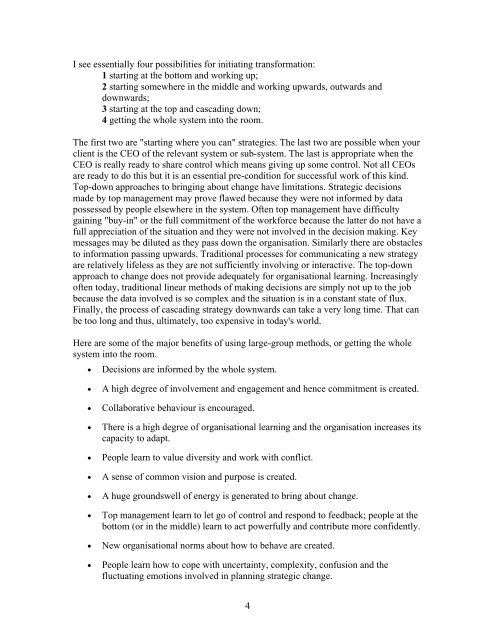Creating the futures we desire - getting the whole ... - Bruce Nixon
Creating the futures we desire - getting the whole ... - Bruce Nixon
Creating the futures we desire - getting the whole ... - Bruce Nixon
You also want an ePaper? Increase the reach of your titles
YUMPU automatically turns print PDFs into web optimized ePapers that Google loves.
I see essentially four possibilities for initiating transformation:<br />
1 starting at <strong>the</strong> bottom and working up;<br />
2 starting somewhere in <strong>the</strong> middle and working upwards, outwards and<br />
downwards;<br />
3 starting at <strong>the</strong> top and cascading down;<br />
4 <strong>getting</strong> <strong>the</strong> <strong>whole</strong> system into <strong>the</strong> room.<br />
The first two are "starting where you can" strategies. The last two are possible when your<br />
client is <strong>the</strong> CEO of <strong>the</strong> relevant system or sub-system. The last is appropriate when <strong>the</strong><br />
CEO is really ready to share control which means giving up some control. Not all CEOs<br />
are ready to do this but it is an essential pre-condition for successful work of this kind.<br />
Top-down approaches to bringing about change have limitations. Strategic decisions<br />
made by top management may prove fla<strong>we</strong>d because <strong>the</strong>y <strong>we</strong>re not informed by data<br />
possessed by people elsewhere in <strong>the</strong> system. Often top management have difficulty<br />
gaining "buy-in" or <strong>the</strong> full commitment of <strong>the</strong> workforce because <strong>the</strong> latter do not have a<br />
full appreciation of <strong>the</strong> situation and <strong>the</strong>y <strong>we</strong>re not involved in <strong>the</strong> decision making. Key<br />
messages may be diluted as <strong>the</strong>y pass down <strong>the</strong> organisation. Similarly <strong>the</strong>re are obstacles<br />
to information passing upwards. Traditional processes for communicating a new strategy<br />
are relatively lifeless as <strong>the</strong>y are not sufficiently involving or interactive. The top-down<br />
approach to change does not provide adequately for organisational learning. Increasingly<br />
often today, traditional linear methods of making decisions are simply not up to <strong>the</strong> job<br />
because <strong>the</strong> data involved is so complex and <strong>the</strong> situation is in a constant state of flux.<br />
Finally, <strong>the</strong> process of cascading strategy downwards can take a very long time. That can<br />
be too long and thus, ultimately, too expensive in today's world.<br />
Here are some of <strong>the</strong> major benefits of using large-group methods, or <strong>getting</strong> <strong>the</strong> <strong>whole</strong><br />
system into <strong>the</strong> room.<br />
• Decisions are informed by <strong>the</strong> <strong>whole</strong> system.<br />
• A high degree of involvement and engagement and hence commitment is created.<br />
• Collaborative behaviour is encouraged.<br />
• There is a high degree of organisational learning and <strong>the</strong> organisation increases its<br />
capacity to adapt.<br />
• People learn to value diversity and work with conflict.<br />
• A sense of common vision and purpose is created.<br />
• A huge grounds<strong>we</strong>ll of energy is generated to bring about change.<br />
• Top management learn to let go of control and respond to feedback; people at <strong>the</strong><br />
bottom (or in <strong>the</strong> middle) learn to act po<strong>we</strong>rfully and contribute more confidently.<br />
• New organisational norms about how to behave are created.<br />
• People learn how to cope with uncertainty, complexity, confusion and <strong>the</strong><br />
fluctuating emotions involved in planning strategic change.<br />
4



